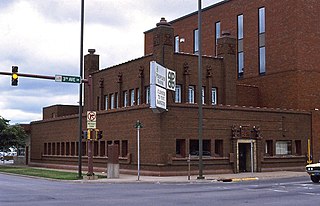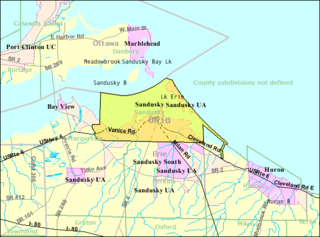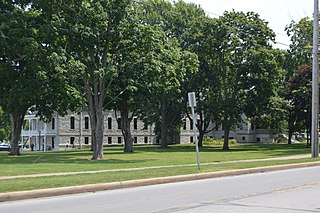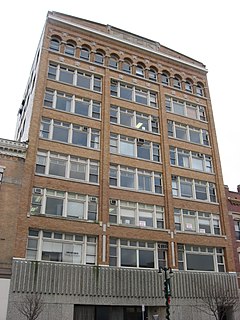William Gray Purcell was a Prairie School architect in the Midwestern United States. He partnered with George Grant Elmslie, and briefly with George Feick. The firm of Purcell & Elmslie produced designs for buildings in twenty-two states, Australia, and China. The firm had offices in Minneapolis, Minnesota; Chicago, Illinois; Philadelphia, Pennsylvania; and Portland, Oregon.

Sandusky is an Amtrak station in Sandusky, Ohio. Located at 1200 North Depot Street, the station consists of an uncovered platform on the north side of the east–west tracks, a small parking lot, and two buildings. The former Railway Express Agency/baggage building is boarded up, while the main building has a small, remodeled waiting room for Amtrak passengers as well as offices for the Sandusky Transit System and North Central EMS.
Purcell & Elmslie (P&E) was the most widely know iteration of a progressive American architectural practice. P&E was the second most commissioned firm of the Prairie School, after Frank Lloyd Wright. The firm in all iterations was active from 1907 to 1921, with their most famous work being done between 1913 and 1921.

The Peoples Savings Bank in Cedar Rapids, Iowa, was designed by Louis Sullivan. It was the second of a number of small "jewel box" banks in midwest towns designed by Sullivan during 1907 to 1919. It was built in 1911, and it was individually listed on the National Register of Historic Places in 1978. In 2014 it was included as a contributing property in the West Side Third Avenue SW Commercial Historic District.

Historic Sandusky is a historic home located in Lynchburg, Virginia. It is a formal two-story, brick "I" house built about 1808, with a later addition. It was built by Charles Johnston, and is one of the earliest homes in the Lynchburg area to display the architectural details and refinements characteristic of Federal design.

The Eleutheros Cooke House at 410 Columbus Avenue in Sandusky, Ohio is the oldest surviving house in Sandusky. It is a Greek Revival style house that was built in 1827 by Eleutheros Cooke, one of the first settlers in the area and its first lawyer. The original front porch of the house saw General William Henry Harrison receive a flag from the women of Sandusky, in 1835.

This is a list of the National Register of Historic Places listings in Sandusky, Ohio.

The Masonic Temple in Sandusky, Ohio, also known as Science Lodge No. 50 F & A M, was built in 1889.

First Congregational Church, also known as First Congregational United Church of Christ, is an historic church located at 431 Columbus Avenue in Sandusky, Ohio. Designed in the Romanesque Revival style of architecture, it was built in 1895 by Sandusky builder George Philip Feick (1849-1932). On October 20, 1982, it was added to the National Register of Historic Places. First Congregational is still an active member of the United Church of Christ.

David Landreth School is a historic school building located in the Point Breeze neighborhood of Philadelphia, Pennsylvania. It was built in 1889 after the original school caught fire.

George Feick was a German-American builder in Sandusky and Oberlin, Ohio. His works include the Wyoming State Capitol, multiple buildings at Oberlin College, and numerous office buildings, churches, schools, libraries and residences in and around Sandusky. Several of his works are listed on the National Register of Historic Places.

The Ezra Abbott House is a historic house in Owatonna, Minnesota, United States. Built in 1913, it was designed by architects Purcell, Feick & Elmslie in Prairie School style patterned onto American Foursquare massing. The house was listed on the National Register of Historic Places in 1986 for having local significance in the theme of architecture. It was nominated for being a leading example of Purcell, Feick & Elmslie's residential commissions in Southeast Minnesota, and for being Steele County's most outstanding Prairie School building.

The Erie County Infirmary near Sandusky, Ohio, which has also been known as the Erie County Home, is listed on the National Register of Historic Places. It was built by George Phillip Feick. It is a large four-story Second Empire-style building made of local limestone.

The Erie County Jail is a historic Stick/Eastlake building located on Adams Street in Sandusky, Ohio. It was built from 1882 to 1883 by the firm of Adam Feick & Brother, which consisted of Adam, Philip, and George Feick. The structure was designed to have 26 cells and a sheriff's residence. It was listed on the National Register of Historic Places in 1982. The building is now part of the Sandusky Library.

The St. Mary's Rectory in Sandusky, Ohio was built in 1893. It was designed and/or built by George Feick. It was listed on the National Register of Historic Places in 1982.

The John Stang House at 629 Columbus Ave. in Sandusky, Ohio was built in 1922 by George Feick. It was listed on the National Register of Historic Places in 1982.

The Taylor-Frohman House at 1315 Columbus Ave. in Sandusky, Ohio was built in 1906. It was built by George Feick. It includes Colonial Revival architecture. It was listed on the National Register of Historic Places in 1982.

The Feick Building is a historic commercial building located at 158-160 E. Market St. in Sandusky, Ohio.

The Campbell School at 1215 Campbell St. in Sandusky, Ohio was built in 1885. It was designed by J.C. Johnson and built by Adam Feick and brothers. It has also been known as the Eighth Ward School. It was listed on the National Register of Historic Places in 1982.

The Edwards Gymnasium/Pfieffer Natatorium on S. Sandusky St. on the main campus of Ohio Wesleyan University was built in 1905. It was designed by architect J.W. Yost and was built by Feick & Son.




















